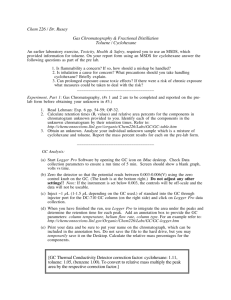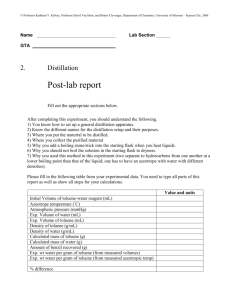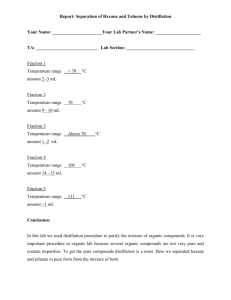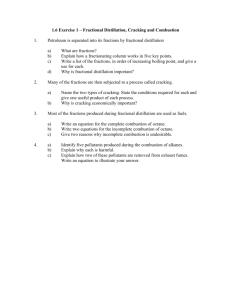Distillation Lecture Notes
advertisement
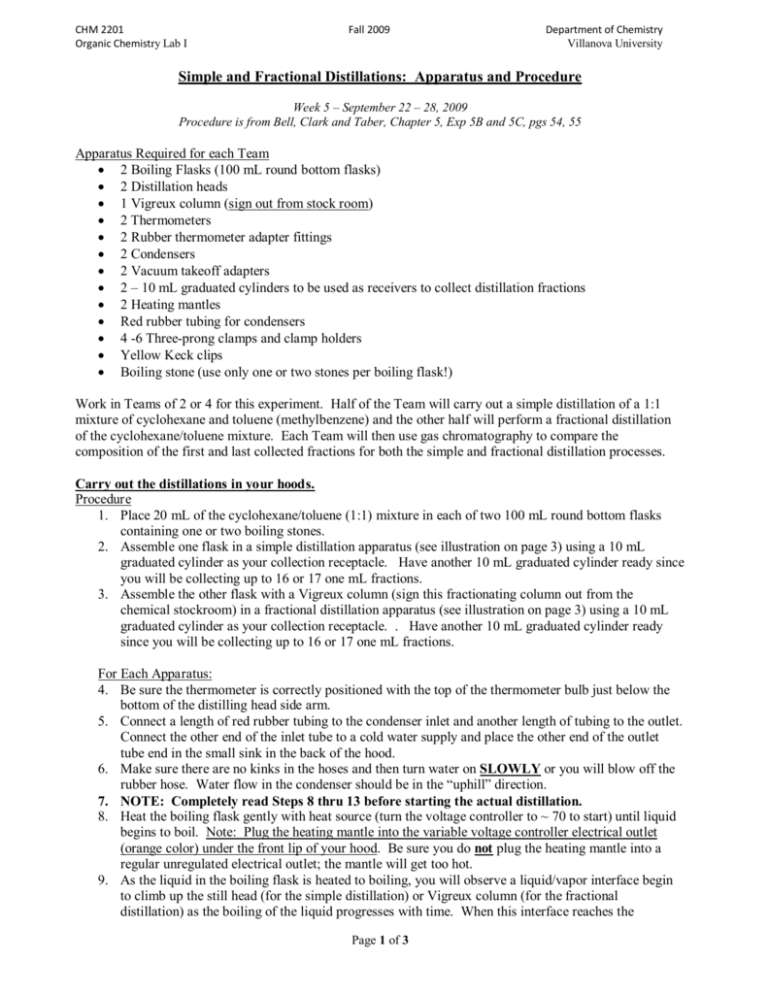
!"# %%&' 9rganic !5emistry Lab I (all %&&+ ,epartment of !5emistr8 Villanova University Simple and Fractional Distillations: Apparatus and Procedure Week 5 – September 22 – 28, 2009 Procedure is from Bell, Clark and Taber, Chapter 5, Exp 5B and 5C, pgs 54, 55 Apparatus Required for each Team ! 2 Boiling Flasks (100 mL round bottom flasks) ! 2 Distillation heads ! 1 Vigreux column (sign out from stock room) ! 2 Thermometers ! 2 Rubber thermometer adapter fittings ! 2 Condensers ! 2 Vacuum takeoff adapters ! 2 – 10 mL graduated cylinders to be used as receivers to collect distillation fractions ! 2 Heating mantles ! Red rubber tubing for condensers ! 4 -6 Three-prong clamps and clamp holders ! Yellow Keck clips ! Boiling stone (use only one or two stones per boiling flask!) Work in Teams of 2 or 4 for this experiment. Half of the Team will carry out a simple distillation of a 1:1 mixture of cyclohexane and toluene (methylbenzene) and the other half will perform a fractional distillation of the cyclohexane/toluene mixture. Each Team will then use gas chromatography to compare the composition of the first and last collected fractions for both the simple and fractional distillation processes. Carry out the distillations in your hoods. Procedure 1. Place 20 mL of the cyclohexane/toluene (1:1) mixture in each of two 100 mL round bottom flasks containing one or two boiling stones. 2. Assemble one flask in a simple distillation apparatus (see illustration on page 3) using a 10 mL graduated cylinder as your collection receptacle. Have another 10 mL graduated cylinder ready since you will be collecting up to 16 or 17 one mL fractions. 3. Assemble the other flask with a Vigreux column (sign this fractionating column out from the chemical stockroom) in a fractional distillation apparatus (see illustration on page 3) using a 10 mL graduated cylinder as your collection receptacle. . Have another 10 mL graduated cylinder ready since you will be collecting up to 16 or 17 one mL fractions. For Each Apparatus: 4. Be sure the thermometer is correctly positioned with the top of the thermometer bulb just below the bottom of the distilling head side arm. 5. Connect a length of red rubber tubing to the condenser inlet and another length of tubing to the outlet. Connect the other end of the inlet tube to a cold water supply and place the other end of the outlet tube end in the small sink in the back of the hood. 6. Make sure there are no kinks in the hoses and then turn water on SLOWLY or you will blow off the rubber hose. Water flow in the condenser should be in the “uphill” direction. 7. NOTE: Completely read Steps 8 thru 13 before starting the actual distillation. 8. Heat the boiling flask gently with heat source (turn the voltage controller to ~ 70 to start) until liquid begins to boil. Note: Plug the heating mantle into the variable voltage controller electrical outlet (orange color) under the front lip of your hood. Be sure you do not plug the heating mantle into a regular unregulated electrical outlet; the mantle will get too hot. 9. As the liquid in the boiling flask is heated to boiling, you will observe a liquid/vapor interface begin to climb up the still head (for the simple distillation) or Vigreux column (for the fractional distillation) as the boiling of the liquid progresses with time. When this interface reaches the Page 1 of 3 !"# %%&' 9rganic !5emistry Lab I 10. 11. 12. 13. 14. 15. 16. 17. (all %&&+ ,epartment of !5emistr8 Villanova University thermometer bulb, the temperature indicated on the thermometer will rapidly rise to around 75-80° C (the approximate boiling point of cyclohexane) and liquid should soon start to be collected in the receiver. Record the temperature when the first drops of distillate are collected in the receiver (10 mL graduated cylinder) and then for each subsequent 1 mL of distillate that is collected; quickly transfer the first 1 mL fraction into a separate container (small test tube or vial) for GC analysis and then continue collecting the remaining fractions in the graduated cylinder, recording the temperature as each mL is collected (since these fractions are not being analyzed by GC, they don’t have to be collected separately). Adjust the heat to distill the liquid at a rate of ~ 1 – 2 mL per minute (1 – 2 drops every 3 seconds). NOTE: As the distillation progresses, you may have to increase the heat controller setting to compensate for the increase in energy needed to distill the higher boiling toluene and to keep the rate of distillation relatively constant at 1 – 2 mL per minute. Collect the last 1 mL fraction (the last fraction can range anywhere from fraction 13 to 17 - the number of fractions collected depends on several factors, i.e. simple vs. fractional distillation, “holdup” volume, technique, etc.) in a separate clean test tube (previously mark a dry test tube to show 1 ml volume) or graduated cylinder and save this last fraction for GC analysis. When the distillation has stopped or slowed significantly, you should have collected a total of 13 – 17 mL of distillate (including the 1st separated fraction). Turn off and remove the heat source and as the boiling flask cools down, ~ 2 – 4 mL of liquid (“holdup”) should remain in the boiling flask. For both the simple and fractional distillations, conduct a GC analysis (TAs will do the sample injections) on the first 1 mL fraction and on the last 1 mL fraction you were able to collect. Record the Retention Times (Rt) for each compound and indicate the % cyclohexane and % toluene (based on integrated peak areas) for the fractions analyzed. Based on the boiling points of cyclohexane and toluene, which material should elute first (lower Rt) on the gas chromatogram? Compare the composition of the first and last fractions from both the simple and fractional distillations. What results did you expect? Did you obtain those results? Make a plot of temperature versus distillate volume for both the simple and fractional distillations on the same graph. What results did you expect? Did you obtain those results? Dispose all fractions in the waste container in the hood, NOT IN YOUR SINKS. Return the Vigreux column to the stockroom. (Example of Table Used to Record Distillation Data) Simple Distillation of 1:1 Cyclohexane/Toluene Fraction Number (1 mL Distillation GC analysis Temperature, °C fractions) 1 (keep separate for GC 80 % cyclohexane; % toluene analysis) 2 82 No analysis necessary 3 85 No analysis necessary 4 -14 Record temp for each 1 No analysis necessary mL fraction collected 15 104 No analysis necessary 16 108 No analysis necessary 17 or the last 1 mL fraction Not enough liquid may be % cyclohexane; % toluene collected (Collect separately present to collect this for GC analysis) entire one mL fraction; if so, use the 16th fraction for GC analysis Pot residue (~2 - 4 mL) No analysis necessary TMBare 9/09 Page 2 of 3 !"# %%&' 9rganic !5emistry Lab I (all %&&+ Simple and Fractional Distillation Set-ups Page 3 of 3 ,epartment of !5emistr8 Villanova University

